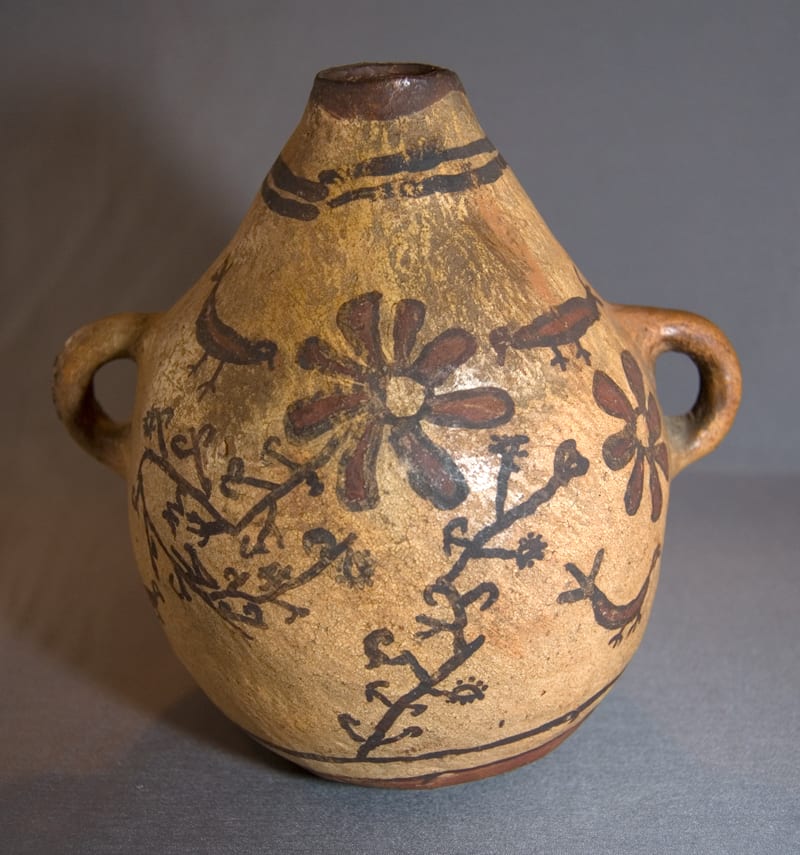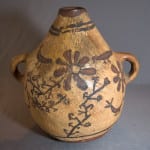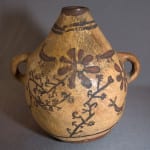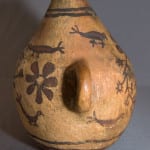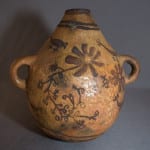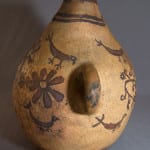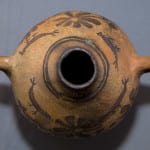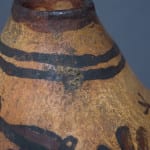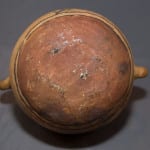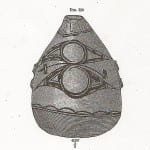- Collected at Hopi ca 1879
According to Wade and McChesney, vertical Polacca canteens of this form are derived from the older San Bernardo tradition (1981:569). The Keam collection contains examples of such San Bernardo canteens (1981:73) and similar Polacca B vessels (1981:138-139), but no Polacca “C” or “D” canteens (1850 to 1900 CE) of this shape.
“The sculptural form of the modern Hopi canteen evolved from a shape introduced in the 16thcentury by Sikyatki potters. Prior to then, canteens were globular or conical, possessing lug or looped handles, and oriented on a vertical axis. They were meant to sit upright (Wade and Cooke, 2012:172).”
The exuberant plant and bird decorative elements on 2010-03, however, are frequently seen on Polacca “C” pottery (Wade and McChesney, 1981:240-242, 368-371 and 451). Similar design motifs appear on Polacca “D” tiles (1981:500). Also see Wade and McChesney (1980:77 and 88).
Steve Elmore has a ca 1890 Polacca bowl for sale with design motifs very similar to canteen 2010-03. (Photograph on file.)

Far right: Upright canteen, A.D. 1860-1875, Polacca Polychrome C, Arizona State Museum catalog #18243
When the spring moisture is sufficient, the desert blooms and birds (and butterflies) gather to feast on nectar. For the Hopi this is a special and sacred time: “siitalpuva,” a “land brightened with flowers.” (For a more detailed discussion see the description of 2010-18 and Hays-Gilpin and Sekaquaptewa, 2006.) Thus birds and flowers are particularly appropriate images on a water canteen.
Canteen 2010-03 has a patina, but 1) shows no signs of use, 2) its handles are relatively thin and might easily break given the weight of a full canteen and 3) it is impractically small. Based on these three characteristics, it seems clear that this pot was made for trade to Anglos, hence my designation of the type as “Polacca C.”
The red lip and red base on 2010-03 are typical of Polacca ware. The two dark framing lines just below the lip and the two just above the red base each have break lines. The smooth white slip has tiny even crackles. Each side has a large red flower associated with black twig designs that themselves display several other small black flowers. Scattered among these flowers are six birds with dachshund pedigrees, all but one facing right. Just to the right and below each handle are additional right-facing birds.
Near the top of the canteen on one side there is a small rough area that may be fuel that stuck to the canteen during firing. The interior of the lip has been smoothed, but below this on the interior one can clearly feel the coils of clay that were used to build the vessel.
The collection of which canteen 2010-03 was a part had a note associated with it. The note reads: “Capt. Geo. Ford brought these back from the west after the Civil War. A friend was getting some for the Smithsonian Institute.” Andy Dohan sold the pot to me on behalf of the widow of Collier M. Martin. Mrs. Martin provided the following genealogy for pot 2010-03.
Pvt. George F. Ford was born on 2/18/1843 in Brimfield, MA. He served with the 13th Mass. Volunteer Infantry 1861-1865 and moved to Nevada in the 1870’s. At age 52 he became ill and died of a heart condition on March 30, 1898. Dr. Collier Ford Martin (born 1/22/1873) then inherited pot 2010, though it is not known how he was related to George F. Ford. Dr. Martin was a renowned proctologist in Philadelphia until his death in 1941. He left pot 2010-03 to his only child, Pauline Martin. It then devolved to her only child, Collier M. Martin (who was named after his grandfather?). After Collier M. Martin’s death, his widow asked Andy Dohan to sell 2010-03 and the three other pots in the collection. (Detailed documentation on file.)
It would, of course, be fascinating to know who the “friend” was who was collecting for the Smithsonian and whether canteen 2010 was collected at the same time. Most likely the friend was Colonel James Stevenson, who headed the first Smithsonian expeditions to Hopi, arriving at Keams Canyon in 1879 and returning in 1880 and 1881. In 1879 alone he collected over 3,000 Hopi artifacts; in 1881 in one month he collected almost 5,000 specimens at Hopi, weighing 12,000 pounds (Stevenson, 1881-1882: XX & LXIV). Stevenson died in 1888. (Graves, 1998:140,142,177, 273 and 277).
Each of Stevenson’s expeditions to Hopi collected canteens. He notes that one canteen (like pot 2010-03) has “birds with crest feathers…and flowers on the body (#1587/41631) and one (“toy-like…very small water vessel, probably intended for children”) has figures of birds on the body (1591/41449). These two vessels are not illustrated, but one small canteen (1591/41449) is shown, see image above. The illustrated pot has the same vertical shape as pot 2010-03, though its handles have been broken off and its design is fairly simple, consisting mostly of Zuni rain-bird motifs (Stevenson, 1880-1881: 381 and fig 520 following page). What Stevenson calls “toy-like canteens,” I suggest, were simply made impractically small for sale to tourists at Keams Trading Post. Hough (1919: following p. 296, PL. 23, #8) shows a double-lobed vertical Polacca canteen with a simple painted design that is part of the Smithsonian collection.
If canteen 2010-03 is Polacca “C” ware made to be traded to Anglos it would have been sold shortly after it was made. If my supposition is correct and Col. Stevenson was the “friend” mentioned in the note, then canteen 2010-03 was most likely collected between 1879 and Col. Stevenson’s death in 1888. Keam’s Trading Post was the only permanent Anglo presence near the reservation and was established in 1874. If Col. Stevenson was not the friend, it seems logical that 2010-03 was collected after 1874 and before Pvt. Ford became ill in 1895.
In a conversation on March 13, 2010, Ed Wade (having seen photographs of the canteen) confirmed my typing of the canteen as “Polacca C”; dated it as from the 1880s; made for sale to Keam and with a shape that for its time was quite unusual. In his catalog of the Keam collection, Alexander Stephen illustrates a small canteen of similar shape to 2010-03 that was used in a Hopi ceremony (Patterson, 1994:74).
Canteen 2010-03 was first offered on eBay and identified as possibly a Zuni canteen. It and the three other pots offered by the seller were actually Hopi Polacca ware from the late 19th century. Since the seller is a collector of paperweights and knows little about southwest Indian pottery, the initial listings asked for enormous prices “or best offer.” The asking price for 2010-03 was $10,000, for example. The strategy worked as a number of knowledgeable dealers and collectors contacted the seller with reasonable offers.

